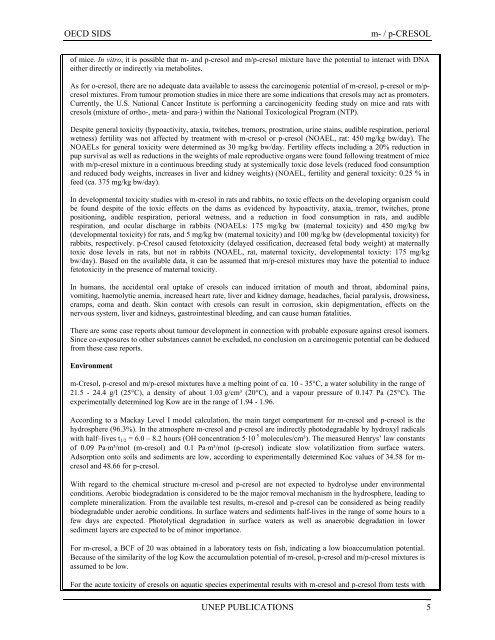m-Cresol - ipcs inchem
m-Cresol - ipcs inchem
m-Cresol - ipcs inchem
You also want an ePaper? Increase the reach of your titles
YUMPU automatically turns print PDFs into web optimized ePapers that Google loves.
OECD SIDS<br />
m- / p-CRESOL<br />
of mice. In vitro, it is possible that m- and p-cresol and m/p-cresol mixture have the potential to interact with DNA<br />
either directly or indirectly via metabolites.<br />
As for o-cresol, there are no adequate data available to assess the carcinogenic potential of m-cresol, p-cresol or m/pcresol<br />
mixtures. From tumour promotion studies in mice there are some indications that cresols may act as promoters.<br />
Currently, the U.S. National Cancer Institute is performing a carcinogenicity feeding study on mice and rats with<br />
cresols (mixture of ortho-, meta- and para-) within the National Toxicological Program (NTP).<br />
Despite general toxicity (hypoactivity, ataxia, twitches, tremors, prostration, urine stains, audible respiration, perioral<br />
wetness) fertility was not affected by treatment with m-cresol or p-cresol (NOAEL, rat: 450 mg/kg bw/day). The<br />
NOAELs for general toxicity were determined as 30 mg/kg bw/day. Fertility effects including a 20% reduction in<br />
pup survival as well as reductions in the weights of male reproductive organs were found following treatment of mice<br />
with m/p-cresol mixture in a continuous breeding study at systemically toxic dose levels (reduced food consumption<br />
and reduced body weights, increases in liver and kidney weights) (NOAEL, fertility and general toxicity: 0.25 % in<br />
feed (ca. 375 mg/kg bw/day).<br />
In developmental toxicity studies with m-cresol in rats and rabbits, no toxic effects on the developing organism could<br />
be found despite of the toxic effects on the dams as evidenced by hypoactivity, ataxia, tremor, twitches, prone<br />
positioning, audible respiration, perioral wetness, and a reduction in food consumption in rats, and audible<br />
respiration, and ocular discharge in rabbits (NOAELs: 175 mg/kg bw (maternal toxicity) and 450 mg/kg bw<br />
(developmental toxicity) for rats, and 5 mg/kg bw (maternal toxicity) and 100 mg/kg bw (developmental toxicity) for<br />
rabbits, respectively. p-<strong>Cresol</strong> caused fetotoxicity (delayed ossification, decreased fetal body weight) at maternally<br />
toxic dose levels in rats, but not in rabbits (NOAEL, rat, maternal toxicity, developmental toxicty: 175 mg/kg<br />
bw/day). Based on the available data, it can be assumed that m/p-cresol mixtures may have the potential to induce<br />
fetotoxicity in the presence of maternal toxicity.<br />
In humans, the accidental oral uptake of cresols can induced irritation of mouth and throat, abdominal pains,<br />
vomiting, haemolytic anemia, increased heart rate, liver and kidney damage, headaches, facial paralysis, drowsiness,<br />
cramps, coma and death. Skin contact with cresols can result in corrosion, skin depigmentation, effects on the<br />
nervous system, liver and kidneys, gastrointestinal bleeding, and can cause human fatalities.<br />
There are some case reports about tumour development in connection with probable exposure against cresol isomers.<br />
Since co-exposures to other substances cannot be excluded, no conclusion on a carcinogenic potential can be deduced<br />
from these case reports.<br />
Environment<br />
m-<strong>Cresol</strong>, p-cresol and m/p-cresol mixtures have a melting point of ca. 10 - 35°C, a water solubility in the range of<br />
21.5 - 24.4 g/l (25°C), a density of about 1.03 g/cm³ (20°C), and a vapour pressure of 0.147 Pa (25°C). The<br />
experimentally determined log Kow are in the range of 1.94 - 1.96.<br />
According to a Mackay Level I model calculation, the main target compartment for m-cresol and p-cresol is the<br />
hydrosphere (96.3%). In the atmosphere m-cresol and p-cresol are indirectly photodegradable by hydroxyl radicals<br />
with half–lives t 1/2 = 6.0 – 8.2 hours (OH concentration 5⋅10 5 molecules/cm³). The measured Henrys’ law constants<br />
of 0.09 Pa⋅m³/mol (m-cresol) and 0.1 Pa⋅m³/mol (p-cresol) indicate slow volatilization from surface waters.<br />
Adsorption onto soils and sediments are low, according to experimentally determined Koc values of 34.58 for m-<br />
cresol and 48.66 for p-cresol.<br />
With regard to the chemical structure m-cresol and p-cresol are not expected to hydrolyse under environmental<br />
conditions. Aerobic biodegradation is considered to be the major removal mechanism in the hydrosphere, leading to<br />
complete mineralization. From the available test results, m-cresol and p-cresol can be considered as being readily<br />
biodegradable under aerobic conditions. In surface waters and sediments half-lives in the range of some hours to a<br />
few days are expected. Photolytical degradation in surface waters as well as anaerobic degradation in lower<br />
sediment layers are expected to be of minor importance.<br />
For m-cresol, a BCF of 20 was obtained in a laboratory tests on fish, indicating a low bioaccumulation potential.<br />
Because of the similarity of the log Kow the accumulation potential of m-cresol, p-cresol and m/p-cresol mixtures is<br />
assumed to be low.<br />
For the acute toxicity of cresols on aquatic species experimental results with m-cresol and p-cresol from tests with<br />
UNEP PUBLICATIONS 5
















